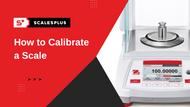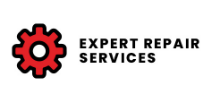How to Calibrate a Scale
Posted by Seth V on Jul 9th 2020
It's well known that Scales Plus offers free product support from our trained technicians. Because of this, we get a ton of questions from customers before and after they purchase their scale or balance. One of the most common questions we get is, "How do I calibrate our scale?"
Whether it's the day your brand new scale arrives at your facility, or perhaps after a few months of regular use, at some point someone will ask how do I calibrate this scale? The answer to this question varies since while all scale calibration procedures are similar, each scale is unique. This blog will explain what calibration is, how to prepare the scale, how to determine what calibration weights to use, and how to perform a calibration properly.
The word calibrate is defined by the Merriam-Webster Dictionary as follows:
1: to ascertain the caliber of (something)
2: to determine, rectify, or mark the graduations of (something like a thermometer tube)
3: to standardize (something, such as a measuring instrument) by determining the deviation from a standard to ascertain the proper correction factors
4: to adjust precisely for a particular function
5: to measure precisely
The third and fourth definitions apply perfectly in the scale calibration industry. The first step in the calibration procedure is to identify the deviation from correct measurements, and make corrections using a known standard. The known standards are calibration weights. The actual modification of the inaccurate measurement is the calibration adjustment. The end goal of calibration is to make a scale or balance perform within the instrument's stated accuracy specifications.
In the scale industry, there are several types of calibration. The first and most common being a span calibration. Span calibration calculates a zero load point followed by one weight drop point. These two test points are saved and help to create the linear calculation that makes up an scale calibration. The second type is known as linear calibration. A linear calibration begins the same as the span calibration in calculating the zero point, however in a linear calibration multiple weight drop points are tested and stored. A linear calibration is used to adjust a scale that is found to not be performing in an accurate linear fashion.
There are two different methods of calibrations, external and internal. "External calibration" means that the scale will need to have known weights placed on the weighing surface to adjust the calibration. "Internal calibration" means that the scale has a built-in internal mechanism designed to correct the calibration. External weights can be used to verify the accuracy of the internal calibration. For more information on external versus internal calibration, check out our blog!
How do I get started with the calibration?
Scales used in legal for trade applications must be NTEP approved and must be sealed after they are calibrated. They are sealed to prevent any tampering with the calibration settings by unauthorized individuals. Licensed technicians typically have to calibrate and seal these units before use. Rules do vary from state to state so it is recommended to check with your local weights and measures department. For more information on the National Type Evaluation Program, check out our blog!
Before proceeding, it is best to find the manual for your particular scale. A manual will show the structure of the menu, how to navigate the menu, and what types of calibrations your scale can do. The manual may even specify which calibration weights are required to perform the calibration adjustment.
The next step is to make sure the environment is acceptable for testing and calibrating. The scale should be clean, leveled, and placed on a solid surface. It is also a good practice to control air movements and temperature changes. To maximize the calibration effectiveness, perform the calibration at the location where the scale is used. Moving scales that are not portable may cause the calibration to change.
The final steps are to determine the allowable tolerances for the scale and what calibration weights are needed. Knowing the allowable tolerance is necessary to determine if the calibration needs to be adjusted. Knowing what accuracy class the calibration weights need to be is necessary to have accurate calibration results.
What is the allowable accuracy tolerance for my scale?
Determining the tolerance for a scale is a critical step in the calibration process. Scales used in legal for trade applications must follow tolerances specified in NIST Handbook 44. Section 2.20, Table 6 of NIST Handbook 44 specifies maintenance tolerances based on Class I through III L. NTEP-approved scales have certificate of conformance (aka CC or COC) numbers. You can use the NTEP Certificate of Conformance Database Search to locate more information about your scale. The CC number will consist of five numbers with a dash separating the second and third numbers. The certificate will provide details about the scale's capacity, readability, and accuracy class, among other things.
To further explain, a Class III bench scale with a 50-pound capacity and a 0.01-pound readability has 5,000 divisions (5,000 x 0.01 = 50lbs). When tested at 5 lbs, or 500 divisions, the scale should be able to perform +/- 1 division or +/- 0.01 pounds. When tested at 50 lbs, or 5,000 divisions, it should perform within +/- 5 divisions or +/- 0.05 lbs.
If a scale is unmarked (not NTEP-approved), then the first place to look to determine your tolerance is with the manufacturer's datasheets. If the manufacturer does not provide tolerance specifications, it will be up to the user to determine an acceptable tolerance for their application.
What weights should I use to calibrate my scale?
Multiple factors determine the calibration weight class needed. It can be a challenge to determine which class of weight to use for your scale. For more information about the different weight classes and where to use them check out our in-depth guide.
Once you have determined the accuracy class of calibration weight needed, you must have the correct nominal weights to complete the calibration. The capacity of the scale helps determine what nominal weights to use.
PRO TIP: Generally it is best to test and calibrate a scale as close to capacity as possible. For a visual example, view the graphs below.
|
Table A 10 lb Capacity Scale Tested to 3 lbs |
Table B 10 lb Capacity Scale Tested to Full Capacity |
|
|
|
Table A depicts the testing of a 10 lb capacity scale at 3 pounds versus Table B, which shows testing it at full capacity. In theory, a scale works on a linear line and should perform well beyond a single calibration point, even if it is not to its maximum capacity. The only factor to consider is that if the scale is not working correctly (in a linear fashion), then Table A could occur.
What type of calibration should I use? (Linear Calibration or Span Calibration)
The only way to test if a scale is linear is to have multiple weight drop points. For scales being used in non-legal for trade applications, the process is as simple as adding a weight drop that is half of the largest available test weight. For example, a ten-pound scale tested to capacity would need a five-pound calibration weight to test the linearity of the scale. If the scale displays 10.00 at the ten-pound test point, but displays 4.98 at the five-pound test point, the scale is not perfectly linear. If the scale shows 4.98 at the five-pound weight drop and 9.96 lb at the ten-pound weight drop, then the scale is linear but may require an adjustment to the span calibration in order to correct the error.
What weight test points should I use?
As stated earlier, it is necessary to have at a minimum 2 data points to calibrate a scale. Beyond that, there is not a simple answer to that question. In a testing procedure for an end-user, the weight test points beyond what we previously stated can be anything the end-user deems appropriate. For a reliable, general example of weight drops, use the following guidelines:
- Zero load
- Low capacity test 1-5% capacity of the scale
- Half of drop point 4
- Full capacity or as close to full capacity as possible
The purpose of drop point 1 is just to verify that the scale is at zero and stable before moving on. Drop point 2 tests that the scale works well on the lower end of the capacity. Drop point 3 and 4 test that the scale is accurate and linear. Now the only thing left to cover in testing is shift tests.
How do I perform a shift/corner test?
A shift test is used to check the performance of a scale or balance in each quadrant or corner. This determines if the scale is weighing accurately no matter where a weight load is placed on the weighing platform. Each corner must have a calibration weight placed on it and the result recorded. The standard in the industry is to start on the top left side of the weighing surface and continue around clockwise to each quadrant numbering them as the test proceeds. Please view Figures 1 and 2 for an example.
What calibration weights are needed to perform a shift test?
Although Handbook 44 applies to NTEP scales, it provides a good method for determining what weight load to use for shift tests. The method defined in Handbook 44 is widely used as the standard throughout the industry on both NTEP and non-NTEP scales and balances. View pages 2-30 and 2-31 of Handbook 44 2020 for the fully defined standard for shift tests.
To summarize Handbook 44, a scale with a 500 kg capacity or less requires a shift test of 30% to 35% of its capacity, as shown in Figure 1. For scales exceeding 500 kg, a shift test of 30% to 35% of its capacity placed at the center of each quadrant (Figure 1) or 25% of its capacity over each corner (Figure 2).
How do I know if I need to calibrate my scale?
Simply put, if your scale does not perform within its allowable tolerance, then it should be calibrated.
For any questions about calibrations, guides, shift tests, or troubleshooting, please contact Scales Plus.
Do you offer calibration services?
Yes! We provide NIST traceable and ISO 17025:2017 accredited calibrations on new and existing equipment. Our scale calibration service is available for the majority of the instruments we sell.
To make things convenient, you can order a traceable and accredited calibration report with your new scale purchase from Scales Plus. These options are available online, or you can request this service for your existing equipment. Our team of technicians provide in-house calibration services, as well as on-site service for our customers in Michigan and surrounding areas.





